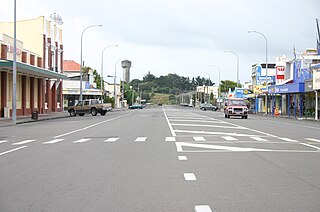Related Research Articles

Foxton is a town in the Manawatū-Whanganui region of New Zealand - on the lower west coast of the North Island, in the Horowhenua district, 30 km (19 mi) southwest of Palmerston North and just north of Levin. The town is located close to the banks of the Manawatū River. It is situated on State Highway 1, roughly in the middle between Tongariro National Park and Wellington.
Arawa was one of the great ocean-going, voyaging canoes in Māori traditions that was used in the migrations that settled New Zealand.
Jolene Douglas is a contemporary New Zealand Māori artist who has been exhibiting since 1983. Two of her art works are in the collection of Museum of New Zealand Te Papa Tongarewa. She is currently living in Gisborne and been a curator Tairawhiti Museum since 1995. Douglas was born in 1950 in Matamata, New Zealand.
Ngāti Raukawa is a Māori iwi with traditional bases in the Waikato, Taupō and Manawatu/Horowhenua regions of New Zealand. In 2006, 29,418 Māori registered their affiliation with Ngāti Raukawa.

Māori traditional textiles are the indigenous textiles of the Māori people of New Zealand. The organisation Te Roopu Raranga Whatu o Aotearoa, the national Māori weavers' collective, aims to preserve and foster the skills of making and using these materials.

Margaret Pattison Staples-Browne, more commonly known as Mākereti or Maggie Papakura, was a New Zealand guide, entertainer and ethnographer. Of Pākehā and Māori descent, she was of Te Arawa and Tūhourangi iwi.

Te Whakaruruhau o Ngā Reo Irirangi Māori is a New Zealand radio network consisting of radio stations that serve the country's indigenous Māori population. Most stations receive contestable government funding from Te Māngai Pāho, the Māori Broadcast Funding Agency, to operate on behalf of affiliated iwi (tribes) or hapū (sub-tribes). Under their funding agreement, the stations must produce programmes in the Māori language, and must actively promote Māori culture.
Pacific Sisters is a collective of Pacific and Māori artists, performers, fashion designers, jewellers and musicians.
Kohai Grace is a New Zealand weaver. Her iwi are Ngāti Toa Rangatira, Ngāti Porou, Te Āti Awa and Ngāti Raukawa.
Karl Rangikawhiti Leonard is a New Zealand carver and weaver of Te Arawa, Ngāti Awa and Ngāti Raukawa descent. He was the first man elected to the committee of the national Māori weavers' collective, Te Roopu Raranga Whatu o Aotearoa.
Christina Hurihia Wirihana is a New Zealand weaver from Te Arawa, Ngāti Maniapoto, Ngāti Pikiao, Ngāti Rangiunora, Ngāti Raukawa, Tainui iwi.
The Te Waka Toi awards are the premier awards in the field of ngā toi Māori. They have been awarded by Creative New Zealand and predecessors since 1986. The awards recognise tohunga, artists and community leaders across all arts forms including visual and performing arts.

Matekino Lawless is a New Zealand master weaver from Ngāti Maniapoto and Ngāti Whawhakia iwi. Her work is held at marae, in private collections, in the collections of New Zealand and international museums, and at the Headquarters of the United Nations.
Awhina Tamarapa is a New Zealand Māori museum curator and writer in the field of museum studies. She has tribal affiliations to Ngāti Kahungunu, Ngāti Ruanui and Ngāti Pikiao.

Edna Pahewa is a New Zealand weaver and was the head of weaving at Te Rito, the weaving school of the New Zealand Māori Arts and Crafts Institute, for 18 years. Her work is held in the permanent collection of Te Papa.

Te Awahou Nieuwe Stroom is a multi-cultural, multi-purpose visitor and community hub in Foxton, in the southern part of New Zealand's North Island. The facility hosts some 150,000 users annually - to visit the Maori and Dutch museums, the library or the community rooms, the gallery or the heritage room. Locals take care of their affairs in the Council Service Centre.

Sonia Armana Snowden is a New Zealand Māori tohunga raranga who tutored in arts and weaving at Te Wananga o Raukawa. She identifies with the Ngāpuhi iwi. Her works are held in the collection of Museum of New Zealand Te Papa Tongarewa.
Riria Smith was a master in traditional Māori weaving from Northland in New Zealand. She was affiliated to the iwi Ngāti Kurī and the hapū Pohutiare of Te Aupōuri.
Pip Devonshire is a New Zealand weaver, curator and weaving tutor. Part of the iwi (tribes) of Ngāti Te Au, Ngāti Manomano and Ngāti Raukawa ki te Tonga, Devonshire descends from several notable weavers. She began weaving in the 1980s and graduated from Te Wānanga o Raukawa with a bachelor's degree of design in art in 2000, after which she lectured there two decades. Her works have been exhibited in various New Zealand institutions and galleries, including in the national museum Te Papa. She has also curated various exhibitions and as of 2023 works as a curator at the Mahara Gallery in Waikanae.
References
- 1 2 "Te Taitoa Māori o Te Awahou Trust". www.teawahou.com. Retrieved 4 January 2021.
- 1 2 3 4 5 6 Dykes, Mervyn (6 November 2007). "Weavers works in Foxton exhibition". Manawatū Standard. Retrieved 5 January 2021.
- ↑ "About Karl Leonard - Master Weaver". rakai.co.nz. Retrieved 5 January 2021.
- ↑ "Death search: registration number 1994/39762". Births, deaths & marriages online. Department of Internal Affairs. Retrieved 9 August 2023.
- ↑ "Rangimahora Reihana". geni_family_tree. Retrieved 4 January 2021.
- ↑ "Rangimahora Reihana-Mete". collections.tepapa.govt.nz. Retrieved 4 January 2021.
- ↑ "Ngā puna roimata o Te Arawa / edited by Huia Publishers; Awhina Tamarapa, Shirley-marie Whata, curators". Hutt City Library catalogue. Retrieved 4 January 2021.
- ↑ Duff, Michelle (16 November 2007). "Woven into history". Manawatu Standard. p. 2. ProQuest 314324630 . Retrieved 8 August 2023.
- ↑ "No. 46163". The London Gazette (2nd supplement). 1 January 1974. p. 38.
- 1 2 "Foxton Murals - Creative Places Application". foxtonmurals.library.org.nz. Retrieved 4 January 2021.